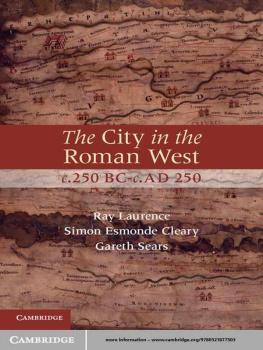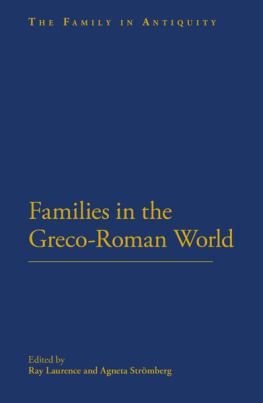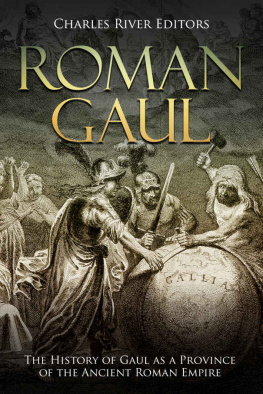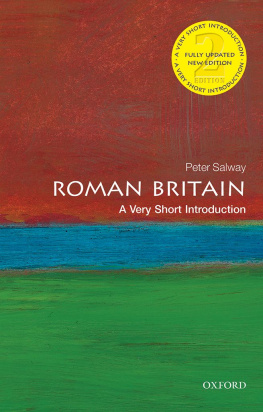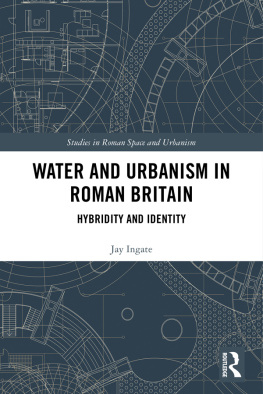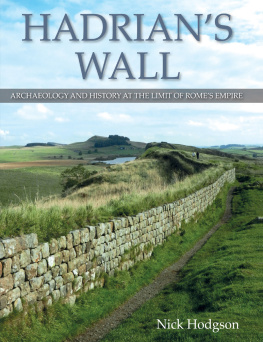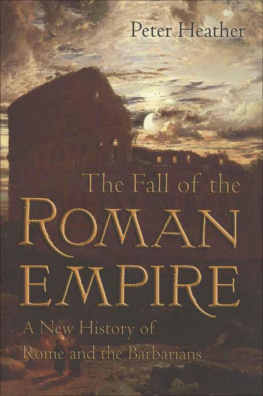The City in the Roman West, c . 250 BC c . AD 250
The city is widely regarded as the most characteristic expression of the social, cultural and economic formations of the Roman Empire. This was especially true in the Latin-speaking West, where urbanism was much less deeply ingrained than in the Greek-speaking East but where networks of cities grew up during the centuries following conquest and occupation. This up-to-date and well-illustrated synthesis provides students and specialists alike with an overview of the development of the city in Italy, Gaul, Britain, Germany, Spain and North Africa, whether their interests lie in ancient history, Roman archaeology or the wider history of urbanism. It accounts not only for the citys geographical and temporal spread and its associated monuments (such as amphitheatres and baths), but also for its importance to the rulers of the Empire as well as the provincials and locals.
RAY LAURENCE is Professor of Roman History and Archaeology at the University of Kent. He has published widely on the history of Ancient Rome, including Roman Pompeii: Space and Society (2nd edition, 2007), The Roman Empire: Rome and its Environs ( The Travellers Guide to the Ancient World ) (2008) and Roman Passions: A History of Pleasure in Imperial Rome (2009).
SIMON ESMONDE CLEARY is Reader in Archaeology at the University of Birmingham. His previous books include The Ending of Roman Britain (1989) and Rome in the Pyrenees: Lugdunum and the Convenae from the First Century BC to the Seventh Century AD (2007).
GARETH SEARS is Lecturer in Ancient History at the University of Birmingham. He is the author of Late Roman African Urbanism (2007).
CAMBRIDGE UNIVERSITY PRESS
Cambridge, New York, Melbourne, Madrid, Cape Town, Singapore, So Paulo, Delhi, Tokyo, Mexico City
Cambridge University Press
The Edinburgh Building, Cambridge CB2 8RU, UK
Published in the United States of America by Cambridge University Press, New York
www.cambridge.org
Information on this title: www.cambridge.org/9780521701402
Ray Laurence, Simon Esmonde Cleary and Gareth Sears 2011
This publication is in copyright. Subject to statutory exception and to the provisions of relevant collective licensing agreements, no reproduction of any part may take place without the written permission of Cambridge University Press.
First published 2011
Printed in the United Kingdom at the University Press, Cambridge
A catalogue record for this publication is available from the British Library.
Library of Congress Cataloguing in Publication data
Laurence, Ray, 1963
The city in the Roman West, c.250 BCcc.AD 250 / Ray Laurence, Simon Esmonde Cleary, Gareth Sears.
p. cm.
ISBN 978-0-521-70140-2 (pbk.)
1. Cities and towns Rome. 2. Urbanization Rome. 3. Sociology, Urban Rome.
4. City planning Rome. I. Esmonde Cleary, A. S. (A. Simon) II. Sears, Gareth, 1977 III. Title.
DG70.A1L38 2011
307.760937dc22
2010053225
ISBN 978-0-521-87750-3 Hardback
ISBN 978-0-521-70140-2 Paperback
Cambridge University Press has no responsibility for the persistence or accuracy of URLs for external or third-party internet websites referred to in this publication, and does not guarantee that any content on such websites is, or will remain, accurate or appropriate.
Preface
The city is widely regarded as the most characteristic expression of the social, cultural and economic formations of the Roman empire, perhaps especially in the Latin-speaking areas of the empire where urbanism was much less deeply engrained than in the Greek East. Yet there is no textbook (or book for that matter) that provides students with an overview of the city in the western Roman Empire. There are numerous reasons for this, one being that most academics focus on the study of the city in a single province or within a limited geographical region. We took a step to overcome this limitation to our understanding of the Roman city and began a dialogue that shared our expertise on the Roman city in North Africa (Sears); in Italy (Laurence) and in the North-West provinces (Esmonde Cleary). This three-way discussion produced some unexpected results that altered the way we conceived of the Roman city: certainly all of us gained from the experience. What it showed was that any single region could not encapsulate the variation in form, time and space associated with the Roman city. The results of our discussion are presented here.
We have used standard conventions and abbreviations for referring to ancient authors; these can be found in The Oxford Classical Dictionary (2nd edition edited by S. Hornblower and A.J. Spawforth) and for abbreviations of journals see LAnne Epigraphique . Although we have included numerous plans and illustrations etc., we refer readers to The Barrington Atlas of the Greek and Roman World (edited by R. J. A. Talbert) for locations of cities mentioned in the text.
We wish to acknowledge the support of colleagues in the Institute of Archaeology and Antiquity at the University of Birmingham, in particular Henry Buglass and Graham Norrie who went beyond the call of duty in the production of the line drawings and photographs respectively and deserve our warmest thanks. Michael Sharp at Cambridge University Press has consistently provided support for this project. The comments of the five anonymous referees, three who reported on the original proposal and two who reported on the text, have our warmest thanks for raising a number of issues that we had not foreseen. Sections of the book have been read by students at Birmingham, who offered further comments on the ease of use of the volume from their perspective. It has not been possible to take account of publications appearing since May 2009.
Introduction
The city is a wonderfully complex entity; it can be defined as either a physical space of architecture, or as a people living in a single place, or as both of these. Within these definitions a myriad other elements emerge that make the city a very slippery object of analysis. This is as true of the multiple entities categorised as the Roman city as it is of any other urban form. Indeed, the idea that there was a single category, the Roman city, in the western half of the Mediterranean basin throughout the period of almost half a millennium that is the subject of this book, does not stand up to more than a few seconds scrutiny. Indeed, one of the central tenets of this book is that what we see across this huge area and long time-scale is the working out by numerous local communities of their relationship to Rome as expressed through the almost infinite variations on common themes of urban form and urban structures which were first generated in Italy and then adopted and adapted in the provinces. Moreover, analysis of the Roman city has been shaped by a series of explicit and often implicit theoretical positions rather than by any single agreed narrative or type of explanation. Some of these positions have been articulated with reference to social theory, although much that is written on the Roman city has relied on empiricism and reference to an undefined common sense. The Roman city has also featured in debates among scholars of the Roman Empire over Romanisation (and resistance), imperialism, the economy, cultural identity, discrepant experience, and phenomenology, to name but a few. nor to summarise the views of other authors (references are provided and these can be read at first hand). Instead we wish here to explain our view of the Roman city in the light of these discussions in order to articulate the conceptual and theoretical positions which underpin the chapters that follow.

